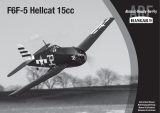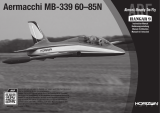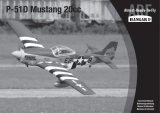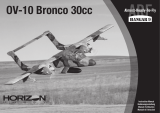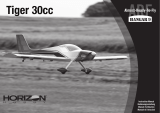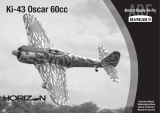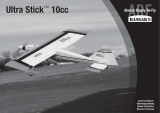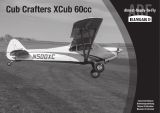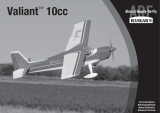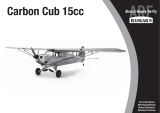La pagina si sta caricando...

P-47D Thunderbolt 20cc
Instruction Manual
Bedienungsanleitung
Manuel d’utilisation
Manuale di Istruzioni

2
SPECIFICATIONS • SPEZIFIKATIONEN • SPÉCIFICATIONS • SPECIFICHE
67 in (1700 mm)
825 sq in (53.2 dm2) Total/Totale
58 in (1473 mm)
11–13 lbs (5–6 kg)
2-Stroke Gas: 20cc, 4-Stroke gas/petrol: 20cc
2-Takt Benziner: 20cc, 4-Takt Benzin: 20 cc
2 temps Essence: 20cc, 4 temps essence: 20cc
2-Tempi Gas: 20cc, 4 tempi benzina: 20 cc
Electric Power: Power 60, 470Kv Brushless
Elektro Antrieb Power: Power 60, 470Kv Brushless
Moteur électrique (EP): Power 60, 470Kv Brushless
Motore elettrico: Power 60, 470Kv Brushless
7-channel (or greater) with 8 servos
7-Kanal (oder größer) mit 8-Servos
7 voies (ou plus) avec 8 servos
a 7 canali (o più) con 8 servo
Spinner: 1-inch (Not Included)
Spinner: 25mm (Nicht enthalten)
Cône: 25mm (Non fourni)
Ogiva dell’elica: 25mm (Non inclusa)
6
1
/
4
inches (159mm)
A
H
K
S
R
L
T
O
N
Q
F
B
C
D
E
M
P
J
I
U
G

3
P-47D Thunderbolt 20cc
Part # English Deutsch Français Italiano
REPLACEMENT PARTS • ERSATZTEILE • PIÈCES DE RECHANGE • PEZZI DI RICAMBIO
A
HAN299001 Fuselage with Hatch Rumpf mit Haube Fuselage avec capot Fusoliera con portello
B
HAN299002 Left Wing with Aileron and Flap Tragfl äche Links mit Querruder und Klappe Aile gauche avec aileron et volet Semiala sinistra con alettone e fl ap
C
HAN299003 Right Wing with Aileron and Flap Tragfl äche Rechts mit Querruder und Klappe Aile droite avec aileron et volet Semiala destra con alettone e fl ap
D
HAN299004 Stabilizer with Elevator Höhenruderset Set Plan horizontal et Gouverne de profondeur Set stabilizzatore ed elevatore
E
HAN299005 Rudder Seitenleitwerk Gouverne de direction Timone
F
HAN299006 Cowling Motorhaube Capot moteur Carenatura
G
HAN299007 Top Hatch Obere Abdeckung Trappe supérieure Portello superiore
H
HAN299008 Canopy Kabinenhaube Verrière Calotta
I
HAN299009 Pilot Lackierter Pilot Pilote peint Pilota verniciato
J
HAN299010 Pushrod Set Gestänge / Anlenkungen Set Jeu de tringleries Set dell’asta di spinta
K
HAN299012 Main Wheels Fahrwerksräder Set Paire de roues principales Set ruota principale
L HAN299013 Decal Set (3) Dekorbogen (3) Planche de décoration (3) Set di decalcomanie (3)
M
HAN299014 Tailwheel Spornrad Roue de queue Ruotino di coda
N
HAN299015 Fixed Landing Gear Starres Fahrwerk Train d’atterrissage fi xe Set del carrello di atterraggio fi sso
O
HAN299016 Main Landing Gear Struts Hauptfahrwerk-Streben Jambes du train d’atterrissage principal Gambe del carrello di atterraggio principale
P HAN299017 Wing Tube Tragfl ächenverbinder Clé d’aile Tubo dell’ala
Q
HAN299018 Fuel Tank Kraftstofftank Réservoir de carburant Serbatoio del carburante
R
HAN299019 Engine/Motor Mount Motor-/Motorhalterung Support du moteur Supporto motore
S
HAN299020 Radiators and Exhausts Kühler und Auspuffe Radiateurs et échappements Radiatori e scarichi
T
HAN299021 Gear Door Set Fahrwerkklappen-Satz Jeu de trappes de train Set portello del carrello
U
HAN299022 Scale Detail Parts Maßstabsgetreue Details Pièces de détails à l’échelle Dettagli in scala
SMALL PARTS (NOT SHOWN) • KLEINTEILE (NICHT ABGEBILDET) • PETITES PIÈCES (NON REPRÉSENTÉES) • PARTI DI PICCOLE DIMENSIONI (NON MOSTRATE)
HAN299011 Hardware Set Kleinteile Set Sachet de visserie Set dei pezzi
REQUIRED RADIO EQUIPMENT • ERFORDERLICHE RC AUSRÜSTUNG • ÉQUIPEMENT RADIO REQUIS • APPARECCHIATURE RADIO NECESSARIE
SPMA3000 (3) Heavy-Duty Servo Extension 3-inch Servokabelverlängerung 75 mm (3 inch) Rallonge de servo, 75 mm Estensione servo 3 pollici
SPMA3001 (2) Heavy-Duty Servo Extension 6-inch Servokabelverlängerung 150 mm (6 inch) Rallonge de servo, 151 mm Estensione servo 6 pollici
SPMA3002 (2) Heavy-Duty Servo Extension 9-inch Servokabelverlängerung 230 mm (9 inch) Rallonge de servo, 230 mm Estensione servo 9 pollici
SPMA3003 (2) Heavy-Duty Servo Extension 12-inch Servokabelverlängerung 300 mm (12 inch) Rallonge de servo, 300 mm Estensione servo 12 pollici
SPMA3008 Heavy-Duty Y-Harness 6-inch Heavy Duty Y-Kabelbaum, 152mm (6Zoll) Harnais résistant en Y de 15 cm (6 po) Prolunga a Y Heavy Duty, 15 cm
SPMAR9350 AR9350 9 Channel AS3X Receiver AR9350 9-Kanal AS3X-Empfänger Récepteur AS3X 9 canaux AR9350 Ricevitore AS3X a 9 canali AR9350

4
Part # English Deutsch Français Italiano
2-STROKE GAS • 2-TAKT BENZINER • 2 TEMPS ESSENCE • 2-TEMPI A BENZINA
APC15080 Competition Propeller, 15 x 8 Competition Propeller, 15 x 8 Hélice 15 x 8 Competition Elica da competizione, 15 x 8
DUB799 Tygon Gas Tubing, 3-foot Medium Tygon-Gasrohre, 1 m (3 Fuß) m Durchschnitt Tube à essence Tygon, 91,4 cm (3 pi) moyen Tubo per carburante Tygon, 3 piedi, medio
EVOA112 (2) Evolution 3 Wire Ignition/Receiver Switch Evolution Zündschalter Interrupteur Evolution 3 fi ls Allumage/RX
Evolution, interruttore a 3 fi li accensione/
ricevitore
EVOE20GX2 20GX Gas Engine with Pumped Carb 20GX 20cc (1.20 cu. in.) Benzinmotor Moteur essence 20GX 20cc Motore a benzina 20GX 20cc (1.20 cu. in.)
HAN116 Fuel Filler with “T” and Overfl ow Fitting Hangar 9 Tanknippel mit T Stück u. Überlauf Fitting Point de remplissage de carburant avec coupleur en T Bocchettone di riempimento carburante con
HAN279012 1-inch Spinner Nut 5/16 x 24: P-47D-1 1Zoll Spinner-Mutter, 5/16 x 24: P-47D-1 Écrou de cône de 2,54 cm (1 po), 5/16 x 24: P-47D-1 Dado dell’ogiva da 2,54 mm 5/16 x 24: P-47D-1
SPMB2000LPRX 2000mAh 2S 7.4V LiPo Receiver Battery LiPo-Empfängerakku (7,4 V / 2000 mAh) Batterie Li-Po de récepteur 7,4 V 2000 mAh Batteria per ricevitore da 7,4 V Li-Po, 2.000 mAh
SPMB4000LPRX 4000mAh 2S 7.4V LiPo Receiver Battery LiPo-Empfängerakku (7,4 V / 4000 mAh) Batterie Li-Po de récepteur 7,4 V 4000 mAh Batteria per ricevitore da 7,4 V Li-Po, 4.000 mAh
SPMSA6110 (8) A6110 HV Standard Servo A6110 HV Standard Servo Servo standard A6110 HV Servo standard A6110 HV
ELECTRIC POWER • ELEKTROANTRIEB • MOTEUR ELECTRIQUE (EP) • MOTORE ELETTRICO
EFLM4060B Power 60 BL Outrunner Motor, 470Kv Bürstenloser Außenläufer-Motor Leistung 60, 470Kv
Moteur à cage tournante sans balais
Power 60 de 470Kv
Motore brushless a cassa rotante
Power 60, 470Kv
CSE010009700 Talon 90-Amp 25V BL ESC W/20amp BEC
Talon 90 A 25 V bürstenloser
Geschwindigkeitsregler mit 20 A BEC
Variateur ESC Talon 90 A 25 V BL avec BEC 20 A ESC BL Talon 90-Amp 25 V con BEC 20amp
EFLB50006S50 5000mAh 6S 22.2V 50C LiPo, 10AWG: EC5 5000 mA 6S 22,2 V 30C LiPo-Akku,10 AWG EC5
Batterie Li-Po 6S 22,2V 5000mA 30C, 10AWG prise
EC5
Batteria LiPo 30C 22,2V 6S 5000 mAh,10AWG
EC5
KXSB0029
22.2V 7000mAh 30C 6S LiPo Battery,
10AWG: EC5 (Optional)
22,2V 7000mAh 30C 6S LiPo-Akku,
10AWG: EC5 (Optional)
Batterie LiPo 30 C 6 S, 22,2 V, 7000 mAh,
10 AWG: EC5 (Facultatif)
Batteria 7000 mAh 6S 22,2 V 30C LiPo,
10 AWG: EC5 (opzionale)
APC16080E Electric Propeller, 16 x 8E Elektro Propeller, 16 x 8E Hélice électrique, 16 x 8E Elica elettrica sottile, 16 x 8E
EFLM1934 Propeller Adapter, 8mm Shaft: Power 46/60 Propelleradapter: Power 46/52/60 Adaptateur d’hélice : 46/52/60 Adattatore dell’elica: Power 46/52/60
HAN279011 1-inch Spinner Nut 8 x 1.25: P-47D-1 1-Zoll Spinner-Mutter, 8 x 1,25: P-47D-1 Écrou de cône de 2,54 cm (1 po), 8 x 1,25: P-47D-1 Dado dell’ogiva da 2,54 mm 8 x 1,25: P-47D-1
EFLAEC506 EC5 Extension Lead with 6-inch Wire, 10Awg EC5 Verlängerungsleitung mit 6-Zoll-Kabel, 10Awg Rallonge EC5 avec fi l de 15 cm (6 po), 10 AWG
Cavo di prolunga EC5 con fi lo da 15,24 cm, 10
AWG
SPMSA6110 (7) A6110 HV Standard Servo A6110 HV Standard Servo Servo standard A6110 HV Servo standard A6110 HV
OPTIONAL ELECTRIC RETRACTS • OPTIONALES ELEKTRISCHES EINZIEHFAHRWERK • TRAINS RÉTRACTABLES ÉLECTRIQUES OPTIONNELS • ELEMENTI RETRATTILI ELETTRICI OPZIONALI
EFLG510
60-120 85-degree Strut Ready
Main Electric Retract
60-120 85-Grad-Hauptfahrwerkstrebe, elektrisch
einziehbar
Système de rentrée électrique principal à 85 degrés
60-120, prêt à être monté sur jambe
Elemento retrattile elettrico principale 60-120,
85 gradi, pronto da montare
EFLG510P47 60-120 P-47 Main Strut Set 60-120 P-47 Hauptfahrwerk-Strebensatz Ensemble de jambes principal P-47, 60-120 Set gamba principale 60-120 P-47
SPMA3001 (2) Heavy-Duty Servo Extension 6-inch Servokabelverlängerung 150 mm (6 inch) Rallonge de servo, 151 mm Estensione servo 6 pollici
REQUIRED ADHESIVES • ERFORDERLICHE KLEBSTOFFE • TYPES DE COLLES • ADESIVI NECESSARI
DLMAD44 Roket Rapid CA 5-10 sec: 20g Roket Rapid CA 5-10 s: 20g Colle cyano Roket Rapid 5-10 sec: 20g Colla cianoacrilica Roket Rapid 5-10 sec: 20 g
DLMAD45 Roket Max CA 10-20 sec: 20g Roket Max CA 10-20 s: 20g Colle cyano Roket Max 10-20 sec: 20g Colla cianoacrilica Roket Max 10-20 sec: 20 g
PAAPT715 CA Accelerator Sekundenkleber (CA) Aktivator Accélérateur de colle CA Accelerante colla CA
PAAPT37 5-Minute Epoxy 5 Minuten Epoxy Époxy 5 minutes Colla epossidica 5 minuti
PAAPT35 15-Minute Epoxy 15 Minuten Epoxy Époxy 15 minutes Colla epossidica 15 minuti
PAAPT39 30-Minute Epoxy 30 Minuten Epoxy Époxy 30 minutes Colla epossidica 30 minuti
PAAPT42 Threadlock Schraubensicherungslack Frein-fi let Frenafi letti
DLMAD12 R/C Modeller Canopy Glue: 4 oz R/C Modeller Kanzelkleber: 113,4g (4 oz) Colle à verrière R/C Modeller: 113g Colla per capottine R/C Modeller: 4 oz

5
P-47D Thunderbolt 20cc
Part # English Deutsch Français Italiano
REQUIRED TOOLS • BENÖTIGTES WERKZEUG • OUTILS REQUIS • ATTREZZI NECESSARI
Box wrench: 1/2-inch Ringschlüssel: 1/2-inch Clé hexagonale: 1/2-inch Chiave esagonale: 1/2-inch
Drill Bohrer Mini-perceuse Trapano
Drill bit: 1/16-inch, 5/64-inch, 1/8-inch
5/32-inch, 3/16-inch
Bohrer: 1,5mm, 2mm, 3mm, 4mm, 4,5mm Forêt : 1,5mm, 2mm, 3mm, 4mm, 4,5mm
Punte per trapano: 1,5mm, 2mm, 3mm, 4mm,
4,5mm
Felt-tipped pen Faserstift Feutre fi n effaçable Pennarello
Epoxy brush Pinsel Pinceau Epoxy Spazzole epoxy
Flat fi le Flachfeile Lime plate Lima piatta
Hemostats Klemme Pince Hemostat Pinzetta
Hex wrench: 3/32-inch, 1.5mm, 2mm, 2.5mm,
3mm, 4mm
Inbusschlüssel: 3/32-inch, 1,5mm, 2mm, 2,5mm,
3mm, 4mm
Tournevis hexagonal: 3/32-inch, 1,5mm, 2mm, 2,5mm,
3mm, 4mm
Chiave esag.: 3/32-inch, 1,5mm, 2mm, 2,5mm,
3mm, 4mm
Hobby knife with #11 blade Hobbymesser mit # 11 Klinge Couteau : Lame numéro 11 Taglierino: #11 lama
Isopropyl alcohol Isopropyl Alkohol Alcool isopropylique Alcol isopropilico
Low-tack tape Kreppband Adhésif de masquage Nastro a bassa aderenza
Needle nose pliers Spitzzange Pince fi ne Pinze a becco stretto
Nut driver: 1/4-inch, 4mm, 5.5mm Steckschlüssel. 1/4-inch, 11/32-inch Clés à douilles : 1/4-inch, 11/32 pouce Chiave per dadi: 1/4-inch, 11/32-inch
Paper towels Papiertücher Papier absorbant Asciugamani di carta
Pencil Stift Crayon à papier Matita
Phillips screwdriver: #1 Phillips Schraubendreher: #1 Tournevis cruciforme: #1 Cacciavite a croce: #1
Pin vise Handbohrer Porte forets Trapano manuale
Pliers Zange Pince Pinze
Ruler Lineal Réglet Righello
Sandpaper Schleifpapier Papier de verre Carta vetrata
Scissors Schere Ciseaux Forbici
Side cutters Seitenschneider Pince coupante Lama laterale
Square Geodreieck Équerre Squadra
Tap and drill set, English Gewindeschneider und Bohrerset Taraud et foret Set punte e maschi, Inglese
Tap Handle Halter für Gewindeschneider Épingles Impugnatura per maschiare
T-pins T- Nadeln Epingles Spilli a T
Toothpicks Zahnstocher Cure dents Stuzzicadenti
OPTIONAL ITEMS • OPTIONALE TEILE • ÉLÉMENTS OPTIONNELS • ARTICOLI OPZIONALI
EVOA100 Optical Ignition Kill Switch Optischer Zünd-Notausschalter Coupe-circuit optique d’allumage Sezionatore ottico accensione
SPMA3008 (2) Heavy-Duty Y-Harness 6-inch Heavy Duty Y-Kabelbaum, 152mm (6Zoll) Harnais résistant en Y de 15 cm (6 po) Prolunga a Y Heavy Duty, 15 cm
SPMA3054 Servo Connector Clips (25) Servosteckerklemmen (25) Attaches de connexion du servo (25) Morsetti servocomando (25)

6
NOTICE
All instructions, warranties and other collateral documents are subject to change at the sole discretion of Horizon
Hobby, LLC. For up-to-date product literature, visit horizonhobby.com and click on the support tab for this product.
The following terms are used throughout the product literature to indicate various levels of potential harm when
operating this product:
Meaning of Special Language
WARNING: Procedures, which if not properly followed, create the probability of property damage, collateral damage,
and serious injury OR create a high probability of superfi cial injury.
CAUTION: Procedures, which if not properly followed, create the probability of physical property damage AND a
possibility of serious injury.
NOTICE: Procedures, which if not properly followed, create a possibility of physical property damage AND a little or
no possibility of injury.
WARNING: Read the ENTIRE instruction manual to become familiar with the features of the product before operating.
Failure to operate the product correctly can result in damage to the product, personal property and cause serious
injury.
This is a sophisticated hobby product. It must be operated with caution and common sense and requires some basic
mechanical ability. Failure to operate this Product in a safe and responsible manner could result in injury or damage
to the product or other property. This product is not intended for use by children without direct adult supervision. Do
not attempt disassembly, use with incompatible components or augment product in any way without the approval
of Horizon Hobby, LLC. This manual contains instructions for safety, operation and maintenance. It is essential to
read and follow all the instructions and warnings in the manual, prior to assembly, setup or use, in order to operate
correctly and avoid damage or serious injury.
AGE RECOMMENDATION: NOT FOR CHILDREN UNDER 14 YEARS. THIS IS NOT A TOY.
USING THE MANUAL
This manual is divided into sections to help make assembly easier to understand.
SAFETY WARNINGS AND PRECAUTIONS
Read and follow all instructions and safety precautions before use. Improper use can result in fi re, serious injury and
damage to property.
Components
Use only with compatible components. Should any compatibility questions exist, please refer to the product
instructions, component instructions or contact the appropriate Horizon Hobby offi ce.
Flight
Fly only in open areas to ensure safety. It is recommended fl ying be done at radio control fl ying fi elds. Consult local
ordinances before choosing a fl ying location.
Propeller
Keep loose items that can become entangled in the propeller away from the prop. This includes loose clothing or other
objects such as pencils and screwdrivers. Keep your hands away from the propeller as injury can occur.
Batteries
Always follow the manufacturer’s instructions when using and disposing of any batteries. Mishandling of Li-Po
batteries can result in fi re causing serious injury and damage.
Small Parts
This kit includes small parts and should not be left unattended near children as choking and serious injury could result.
SAFE OPERATING RECOMMENDATIONS
• Inspect your model before every fl ight to ensure it is airworthy.
• Be aware of any other radio frequency user who may present an interference problem.
• Always be courteous and respectful of other users in your selected fl ight area.
• Choose an area clear of obstacles and large enough to safely accomodate your fl ying activity.
• Make sure this area is clear of friends and spectators prior to launching your aircraft.
• Be aware of other activities in the vicinity of your fl ight path that could cause potential confl ict.
• Carefully plan your fl ight path prior to launch.
• Abide by any and all established AMA National Model Aircraft Safety Code.
BEFORE STARTING ASSEMBLY
• Remove parts from bag.
• Inspect fuselage, wing panels, rudder and stabilizer for damage.
• If you fi nd damaged or missing parts, contact your place of purchase.
• Charge transmitter and receiver batteries.
• Center trims and sticks on your transmitter.
• For a computer radio, create a model memory for this particular model.
• Bind your transmitter and receiver, using your radio system’s instructions.
IMPORTANT: Rebind the radio system once all control throws are set. This will keep the servos from moving to
their endpoints until the transmitter and receiver connect. It will also guarantee the servo reversal settings are
saved in the radio system.
FAA INFORMATION
If you own this product, you may be required to register with the FAA.
For up-to-date information on how to register with the FAA, please visit https://registermyuas.faa.gov/.
For additional assistance on regulations and guidance on UAS usage, visit knowbeforeyoufl y.org/.
BUILDING PRECAUTIONS
During assembly, we recommend resting the parts on a soft surface such as a soft towel to help prevent denting the
sheeting.

7
P-47D Thunderbolt 20cc
Propeller
Halten Sie lose Gegenstände die sich im Propeller verfangen können weg vom Propeller. Dieses gilt auch für Kleidung
oder andere Objekte wie zum Beispiel Stifte oder Schraubendreher.
Halten Sie ihre Hände weg vom Propeller, es besteht akute Verletzungsgefahr.
Akkus
Folgen Sie immer den Herstelleranweisungen bei dem Gebrauch oder Entsorgung von Akkus. Falsche Behandlung von
LiPo Akkus kann zu Feuer mit Körperverletzungen und Sachbeschädigung führen.
Kleinteile
Dieser Baukasten beinhaltet Kleinteile und darf nicht unbeobachtet in der Nähe von Kindern gelassen werden, da die
Teile verschluckt werden könnten mit ernsthaften Verletzung zur Folge.
EMPFEHLUNGEN ZUM SICHEREN BETRIEB
• Überprüfen Sie zur Flugtauglichkeit ihr Modell vor jedem Flug.
• Beachten Sie andere Piloten deren Sendefrequenzen ihre Frequenz stören könnte.
• Begegnen Sie anderen Piloten in ihrem Fluggebiet immer höfl ich und respektvoll.
• Wählen Sie ein Fluggebiet, dass frei von Hindernissen und groß genug ist.
• Stellen Sie vor dem Start sicher, dass die Fläche frei von Freunden und Zuschauern ist.
• Beobachten Sie den Luftraum und andere Flugzeuge/Objekte die ihren Flugweg kreuzen und zu einem Konfl ikt
führen könnten.
• Planen Sie sorgfältig ihren Flugweg vor dem Start.
VOR DEM ZUSAMMENBAU
• Entnehmen Sie zur Überprüfung jedes Teil der Verpackung.
• Überprüfen Sie den Rumpf, Tragfl ächen, Seiten- und Höhenruder auf Beschädigung.
• Sollten Sie beschädigte oder fehlende Teile feststellen, kontaktieren Sie bitte den Verkäufer.
• Laden des Senders und Empfängers.
• Zentrieren der Trimmungen und Sticks auf dem Sender.
• Sollten Sie einen Computersender verwenden, resetten Sie einen Speicherplatz und benennen ihn nach dem Modell.
• Sender und Empfänger jetzt nach den Bindeanweisung des Herstellers zu binden.
WICHTIG: Wir empfehlen dringend nachdem alle Einstellungen vorgenommen worden sind, das Modell neu zu binden.
Dieses verhindert, dass die Servos in die Endanschläge laufen bevor sich Sender und Empfänger verbunden haben. Es
garantiert auch, dass die Servoreverseeinstellungen in der RC Anlage gesichert sind.
HINWEISE ZUM BAU
Während des Zusammenbaus empfehlen wird, dass die Teile auf einer weichen Oberfl äche, wie einem Handtuch,
abgelegt werden, um ein Eindrücken der Bleche zu verhindern.
HINWEIS
Alle Anweisungen, Garantien und anderen zugehörigen Dokumente können im eigenen Ermessen von Horizon Hobby,
LLC. jederzeit geändert werden Die aktuelle Produktliteratur fi nden Sie auf horizonhobby.com unter der Registerkarte
„Support“ für das betreffende Produkt.
Spezielle Bedeutungen
Die folgenden Begriffe werden in der gesamten Produktliteratur verwendet, um auf unterschiedlich hohe
Gefahrenrisiken beim Betrieb dieses Produkts hinzuweisen:
WARNUNG: Wenn diese Verfahren nicht korrekt befolgt werden, ergeben sich wahrscheinlich Sachschäden,
Kollateralschäden und schwere Verletzungen ODER mit hoher Wahrscheinlichkeit oberfl ächliche Verletzungen.
ACHTUNG: Wenn diese Verfahren nicht korrekt befolgt werden, ergeben sich wahrscheinlich Sachschäden UND die
Gefahr von schweren Verletzungen.
HINWEIS: Wenn diese Verfahren nicht korrekt befolgt werden, können sich möglicherweise Sachschäden UND geringe
oder keine Gefahr von Verletzungen ergeben.
WARNUNG: Lesen Sie die GESAMTE Bedienungsanleitung, um sich vor dem Betrieb mit den Produktfunktionen
vertraut zu machen. Wird das Produkt nicht korrekt betrieben, kann dies zu Schäden am Produkt oder persönlichem
Eigentum führen oder schwere Verletzungen verursachen.
Dies ist ein hochentwickeltes Hobby-Produkt. Es muss mit Vorsicht und gesundem Menschenverstand betrieben
werden und benötigt gewisse mechanische Grundfähigkeiten. Wird dieses Produkt nicht auf eine sichere und
verantwortungsvolle Weise betrieben, kann dies zu Verletzungen oder Schäden am Produkt oder anderen Sachwerten
führen. Dieses Produkt eignet sich nicht für die Verwendung durch Kinder ohne direkte Überwachung eines
Erwachsenen. Verwenden Sie das Produkt nicht mit inkompatiblen Komponenten oder verändern es in jedweder Art
ausserhalb der von Horizon Hobby, LLC vorgegebenen Anweisungen. Diese Bedienungsanleitung enthält Anweisungen
für Sicherheit, Betrieb und Wartung. Es ist unbedingt notwendig, vor Zusammenbau, Einrichtung oder Verwendung
alle Anweisungen und Warnhinweise im Handbuch zu lesen und zu befolgen, damit es bestimmungsgemäß betrieben
werden kann und Schäden oder schwere Verletzungen vermieden werden.
NICHT GEEIGNET FÜR KINDER UNTER 14 JAHREN. DIES IST KEIN SPIELZEUG.
ÜBER DIESE ANLEITUNG
Diese Anleitung ist zur Vereinfachung des Zusammenbaues in Sektionen unterteilt.
WARNUNGEN UND SICHERHEITS-VORKEHRUNGEN
Bitte lesen und befolgen Sie alle Anweisungen und Sicherheitsvorkehrungen vor dem Gebrauch. Falscher, nicht
sachgemäßer Gebrauch kann Feuer, ernsthafte Verletzungen und Sachbeschädigungen zur Folge haben.
Komponenten
Verwenden Sie mit dem Produkt nur kompatible Komponenten. Sollten Fragen zur Kompatibilität auftreten, lesen Sie
bitte die Produkt- oder Bedienungsanweisung oder kontaktieren den Service von Horizon Hobby.
Fliegen
Fliegen Sie um Sicherheit garantieren zu können, nur in weiten offenen Gegenden. Wir empfehlen hier den Betrieb auf
zugelassenen Modellfl ugplätzen. Bitte beachten Sie lokale Vorschriften und Gesetze, bevor Sie einen Platz zum Fliegen
wählen.

8
L’hélice
Gardez éloignés tous les éléments qui pourraient être attrapés par l’hélice. Cela inclut les vêtements larges ou les
objets comme des outils par exemple. Gardez toujours vos mains à distance pour éviter tout cas de blessures.
Les batteries
Suivez toujours les instructions du fabricant de vos batteries. Une mauvaise manipulation d’une batterie Li-Po peut
entraîner un incendie causant de graves dégâts matériels et des blessures corporelles.
Petites pièces
Ce kit contient des petites pièces qui ne doivent pas être laissées à la portée des enfants, ces pièces sont dangereuses
pour eux et peuvent entraîner de graves blessures.
CONSIGNES DE SÉCURITÉ CONCERNANT L’UTILISATION
• Inspectez votre modèle avant chaque vol.
• Surveillez les fréquences utilisées à proximité.
• Soyez toujours courtois et respectueux des autres utilisateurs de la zone de vol.
• Choisissez une zone dégagée de tout obstacle et suffi samment grande pour voler en toute sécurité.
• Contrôlez que la zone est libre de spectateurs avant de lancer votre modèle.
• Soyez conscient des autres activités aux alentours de votre vol, risque de confl it potentiel.
• Planifi ez votre vol avant de le commencer.
AVANT DE COMMENCER L’ASSEMBLAGE
• Retirez toutes les pièces des sachets pour les inspecter.
• Inspectez soigneusement le fuselage, les ailes et les empennages.
• Si un élément est endommagé, contactez votre revendeur.
• ll est recommandé de préparer tous les éléments du système de la radio.
• Cela inclut la charge des batteries comme la mise au neutre des trims et des manches de votre émetteur.
• Si vous utilisez une radio programmable, sélectionnez une mémoire libre afi n d’y enregistrer les paramètres de ce
modèle.
• Nous vous recommandons d’affecter maintenant le récepteur à l’émetteur en suivant les instructions fournies avec
votre radio.
IMPORTANT: Il est hautement recommandé de ré-affecter le système une fois que les courses seront réglées. Cela
empêchera les servos d’aller en butée lors de la connexion du système. Cela garantit également que la direction des
servos est enregistrée dans l’émetteur.
PRÉCAUTIONS D’ASSEMBLAGE
Lors de l’assemblage de votre modèle, nous vous recommandons de poser les pièces sur une surface douce comme
une serviette douce pour éviter d’abîmer l’entoilage.
REMARQUE
La totalité des instructions, garanties et autres documents est sujette à modifi cation à la seule discrétion d’Horizon
Hobby, LLC. Pour obtenir la documentation àjour, rendez-vous sur le site horizonhobby.com et cliquez sur l’onglet de
support de ce produit.
Signifi cation de certains termes spécifi ques
Les termes suivants sont utilisés dans l’ensemble du manuel pour indiquer différents niveaux de danger lors de
l’utilisation de ce produit:
AVERTISSEMENT: Procédures qui, si elles ne sont pas suivies correctement, peuvent entraîner des dégâts matériels
et des blessures graves OU engendrer une probabilité élevée de blessure superfi cielle.
ATTENTION: Procédures qui, si elles ne sont pas suivies correctement, peuvent entraîner des dégâts matériels ET des
blessures graves.
REMARQUE: Procédures qui, si elles ne sont pas suivies correctement, peuvent entraîner des dégâts matériels ET
éventuellement un faible risque de blessures.
AVERTISSEMENT: Lisez la TOTALITÉ du manuel d’utilisation afi n de vous familiariser avec les caractéristiques du
produit avant de le faire fonctionner. Une utilisation incorrecte du produit peut entraîner sa détérioration, ainsi que des
risques de dégâts matériels, voire de blessures graves.
Ceci est un produit de loisirs sophistiqué. Il doit être manipulé avec prudence et bon sens et requiert des aptitudes
de base en mécanique. Toute utilisation irresponsable de ce produit ne respectant pas les principes de sécurité peut
provoquer des blessures, entraîner des dégâts matériels et endommager le produit. Ce produit n’est pas destiné à
être utilisé par des enfants sans la surveillance directe d’un adulte. N’essayez pas de modifi er ou d’utiliser ce produit
avec des composants incompatibles hors des instructions fournies par Horizon Hobby, LLC. Ce manuel comporte des
instructions relatives à la sécurité, au fonctionnement et à l’entretien. Il est capital de lire et de respecter la totalité
des instructions et avertissements du manuel avant l’assemblage, le réglage et l’utilisation, ceci afi n de manipuler
correctement l’appareil et d’éviter tout dégât matériel ou toute blessure grave.
14 ANS ET PLUS. CECI N’EST PAS UN JOUET.
UTILISATION DU MANUEL
Ce manuel est divisé en sections pour vous aider à comprendre plus facilement l’assemblage.
AVERTISSEMENTS RELATIFS À LA SÉCURITÉ
Lisez et suivez toutes les instructions relatives à la sécurité avant utilisation. Une utilisation inappropriée peut entraîner
un incendie, de graves blessures et des dégâts matériels.
Composants
Utilisez uniquement des composants compatibles. Si vous avez des questions concernant la compatibilité, référez-vous
à ce manuel ou contactez le service technique Horizon Hobby.
Le vol
Volez uniquement dans des zones dégagées pour un maximum de sécurité. Il est recommandé d’utiliser les pistes des
clubs d’aéromodélisme. Consultez votre mairie pour connaître les sites autorisés.

9
P-47D Thunderbolt 20cc
AVVISO
Tutte le istruzioni, le garanzie e gli altri documenti pertinenti sono soggetti a cambiamenti a totale discrezione di
Horizon Hobby, LLC. Per una documentazione aggiornata sul prodotto, visitare il sito www.horizonhobby.com e fare
clic sulla sezione Support per questo prodotto.
Signifi cato dei termini particolari
In tutta la documentazione relativa al prodotto sono utilizzati iseguenti termini per indicare vari livelli di potenziale
pericolo durante il funzionamento:
AVVERTENZA: Procedure che, se non debitamente seguite, espongono alla possibilità di danni alla proprietà fi sica
opossono omportare un’elevata possibilità di provocare ferite superfi ciali. Ulteriori precauzioni per la sicurezza e
avvertenze.
ATTENZIONE: Procedure che, se non sono seguite correttamente, possono creare danni materiali E possibili gravi
lesioni.
AVVISO: Procedure che, se non sono seguite correttamente, possono creare danni materiali E nessuna oscarsa
possibilità di lesioni.
AVVERTENZA: Leggere TUTTO il manuale di istruzioni e prendere familiarità con le caratteristiche del prodotto, prima
di farlo funzionare. Un utilizzo scorretto del prodotto può causare danni al prodotto stesso, alle persone oalle cose,
provocando gravi lesioni.
Questo è un prodotto di hobbistica sofi sticato e NON un giocattolo. È necessario farlo funzionare con cautela e
responsabilità e avere conoscenze basilari di meccanica. Se questo prodotto non è utilizzato in maniera sicura e
responsabile potrebbero verifi carsi lesioni odanni al prodotto stesso oad altre proprietà. Non è un prodotto adatto
aessere utilizzato dai bambini senza la diretta supervisione di un adulto. Non usare componenti non compatibili
o alterare il prodotto in nessuna maniera al di fuori delle istruzioni fornite da Horizon Hobby, LLC. Questo manuale
contiene le istruzioni per un funzionamento e una manutenzione sicuri. È fondamentale leggere e seguire tutte le
istruzioni e le avvertenze del manuale prima di montare, confi gurare ofar funzionare il Prodotto, al fi ne di utilizzarlo
correttamente e di evitare danni olesioni gravi.
MINIMO 14 ANNI. NON È UN GIOCATTOLO.
COME USARE IL MANUALE
Questo manuale è diviso in sezioni per rendere più facile la comprensione del montaggio.
AVVERTIMENTI E PRECAUZIONI PER LA SICUREZZA
Prima dell’uso leggere attentamente tutte le istruzioni e le precauzioni per la sicurezza. In caso contrario si potrebbero
procurare incendi, danni o ferite.
Componenti
Usare solo componenti compatibili. Se ci fossero dubbi riguardo alla compatibilità, è opportuno far riferimento alle
istruzioni relative al prodotto o ai componenti oppure rivolgersi al reparto Horizon Hobby di competenza.
Volo
Per sicurezza volare solo in aree molto ampie. Meglio se in campi volo autorizzati per modellismo. Consultare le
ordinanze locali prima di scegliere luogo dove volare.
Elica
Tenere gli oggetti liberi (vestiti, penne, cacciaviti, ecc.) lontano dall’elica, prima che vi restino impigliati. Bisogna fare
attenzione anche con le mani perché c’è il rischio di ferirsi anche gravemente.
Batterie
Quando si maneggiano o si utilizzano le batterie, bisogna attenersi alle istruzioni del costruttore; il rischio è di procurare
incendi, specialmente con le batterie LiPo, con danni e ferite serie.
Piccole parti
Questo kit comprende delle parti di piccole dimensioni e non lo si può lasciare incustodito se c’è la presenza di bambini
che li possono inghiottire e rimanere soffocati o intossicati.
RACCOMANDAZIONI PER OPERARE IN SICUREZZA
• Controllare attentamente il modello prima di ogni volo per accertarsi che sia idoneo.
• Essere consapevoli che un altro utente della frequenza in uso, potrebbe procurare delle interferenze.
• Essere sempre cortesi e rispettosi nei confronti degli altri utilizzatori dell’area in cui ci si trova.
• Scegliere un’area libera da ostacoli e abbastanza ampia da permettere lo svolgimento del volo in sicurezza.
• Prima del volo verifi care che l’area sia libera da amici e spettatori.
• Stare attenti alle altre attività che si svolgono in vicinanza della vostra traiettoria di volo, per evitare possibili confl itti.
• Pianifi care attentamente il volo prima di lanciare il modello.
• Rispettare sempre scrupolosamente le regole stabilite dall’associazione locale.
PRIMA DI INIZIARE IL MONTAGGIO
• Togliere tutti i pezzi dalla scatola.
• Verifi care che la fusoliera, l’ala e i piani di coda non siano danneggiati.
• Se si trovano parti danneggiate, contattare il negozio da cui è stato acquistato.
• Caricare il trasmettitore e la batteria di volo.
• Centrare stick e trim sul trasmettitore.
• Con una radio computerizzata creare una nuova memoria per questo modello.
• Facendo riferimento alle istruzioni del radiocomando, connettere (bind) trasmettitore e ricevitore.
IMPORTANTE: Ripetere la procedura di connessione una volta regolate le corse, per evitare che i servi vadano a fi ne
corsa. Garantirà anche che le impostazioni di inversione del servo vengano salvate nel sistema radio.
PRECAUZIONI PER LA COSTRUZIONE
Durante l’assemblaggio noi consigliamo di appoggiare le varie parti su di una superfi cie morbida come un
asciugamano di spugna per evitare ammaccature al rivestimento.

10
TRANSPORTATION AND STORAGE
Use the 3-view drawing at the back of this manual to
determine the amount of space required to transport and
store your model. The model can be disassembled, so the
amount of room necessary can vary. We recommend the
use of a wing bag to help protect these surfaces during
transport and storage. The control horns and linkages can
also cause damage to nearby surfaces even when placed
in storage bags. Always place surfaces so the tops are
together to prevent damage from the control horns and
linkages.
PRINTED COVERING NOTES
• The covering used on your model has the coloring and
markings printed directly on the covering.
• The covering has a self-adhesive backing, and it is
not recommended to use heat as it may damage the
covering.
• Use only mild cleaning agents on the printed fi nish.
Denatured alcohol is the most aggressive agent we
recommend, but test on an inconspicuous area fi rst.
Prolonged use will remove the paint.
• Use tape with care. Anything other than low-tack tape
can remove the fi nish, particularly on edges.
• Avoid contact with raw fuel, especially alcohol-based
fuels containing nitro methane.
• Remove exhaust residue as soon as practical to avoid
staining or damaging of the fi nish.
There are two areas on your aircraft that will receive wear
under normal use. The fi rst area is where the cowling fi ts
over the fuselage hatch, and where the wing fi ts into the
fuselage. Placing a piece of clear tape on the wing where
it fi ts into the fuselage, and on the hatch underneath the
cowling, will reduce the wear on the covering in these
areas. Sanding the inside of the cowling smooth will also
help in preventing wear of the covering under the cowling.
TRANSPORT UND LAGERUNG
Mit der Zeichnung aus drei Ansichten am Ende des
Handbuchs lässt sich ermitteln, wie viel Platz zum
Transport und zur Lagerung des Modells benötigt
wird. Das Modell kann demontiert werden, daher ist
der erforderliche Platz variabel. Die Empfehlung einer
Flügeltasche wird empfohlen, um diese Oberfl ächen bei
Transport und Lagerung zu schützen. Die Steuerhörner
und Gestänge können zudem Schäden an benachbarten
Oberfl ächen verursachen, auch wenn sie in Taschen
gelagert sind. Oberfl ächen stets so platzieren, dass
die Oberseiten aneinander liegen, um Schäden durch
Steuerhörner und Gestänge zu vermeiden.
HINWEISE ZUR BESPANNUNG
• Bei der bei diesem Modell verwendeten Abdeckung
sind Farben und Markierungen direkt auf die
Abdeckung gedruckt.
• Die Abdeckung ist selbstklebend, und ein Erwärmen
wird nicht empfohlen, da die Wärme die Abdeckung
beschädigen könnte.
• Verwenden Sie nur milde Reiniger für die bedruckte
Folie. Als aggressiver Reiniger der noch zu empfehlen
ist, empfehlen wir denaturierten Alkohol. Prüfen
Sie vorher unbedingt an unauffälliger Stelle die
Verträglichkeit. Wiederholte / verlängerte Anwendung
entfernt die Farbe.
• Verwenden Sie Klebeband nur mit äußerster Vorsicht.
Bis auf Kreppband entfernt alle Klebebänder die Farbe.
Dieses gilt insbesondere für die Kanten.
• Vermeiden Sie den Kontakt mit Kraftstoff, insbesondere
Alkohol-basierte Kraftstoffe mit Nitromethan.
• Entfernen Sie Abgasrückstände schnellstmöglich um
ein Verfärben oder Beschädigen der Bespannung zu
vermeiden.
Zwei Stellen Ihres Modells sind bei normalem Gebrauch
Verschleiß ausgesetzt. Bei der ersten Stelle handelt es
sich um den Bereich, in dem die Motorhaube auf der
Rumpfabdeckung sitzt und in dem die Tragfl äche in den
Rumpf führt. Indem Sie die Tragfl äche dort, wo sie in den
Rumpf führt, sowie an der Abdeckung unter der Motorhaube
mit einem Stück transparentem Klebeband versehen,
können Sie den Verschleiß der Abdeckung reduzieren.
Außerdem vermindern Sie den Verschleiß der Abdeckung
unter der Motorhaube, wenn Sie die Innenseite der
Motorhaube mit Sandpapier glattschmirgeln.
TRANSPORT ET STOCKAGE
Utilisez le schéma à 3 vues à l’arrière de ce manuel
pour déterminer l’espace nécessaire pour transporter
et stocker votre maquette. La maquette peut être
démontée, l’espace nécessaire peut donc varier. Nous
vous conseillons d’utiliser un sac à ailes pour protéger ces
surfaces lors du transport et du stockage. Les renvois de
commande et tringleries peuvent également endommager
les surfaces proches même si rangés dans des sacs de
rangement. Placez toujours ces surfaces de manière à
ce que les sommets soient ensemble pour prévenir tout
dommage causé par les renvois de commande et les
tringleries.
REMARQUES RELATIVES À L’ENTOILAGE
IMPRIMÉ
• L’entoilage utilisé sur votre maquette a les couleurs et
les marquages imprimés directement sur l’entoilage.
• L’entoilage a un endos autocollant, et il n’est pas
recommandé d’utiliser de la chaleur car cela peut
endommager l’entoilage.
• Utilisez uniquement des produits de nettoyage doux
sur la surface du fi lm. L’alcool dénaturé est le produit le
plus agressif que vous pouvez utiliser, mais nous vous
conseillons de procéder d’abord à un essai sur une
partie de surface non visible. Une utilisation fréquente
endommagera la peinture présente sur le fi lm.
• Utilisez du ruban adhésif avec précautions. Tout autre
adhésif que de l’adhésif de masquage endommagera la
décoration, surtout au niveau des angles.
• Evitez le contact avec du carburant brut, surtout les
carburants à base d’alcool contenant du nitrométhane.
• Essuyez les résidus de carburant immédiatement après
le vol afi n d’éviter d’endommager la fi nition.
In condizioni di utilizzo normali, sono due le parti
dell’aeromodello soggette a usura. La prima è la giuntura
tra la cappottatura e il portello della fusoliera, l’altra è il
punto di inserimento delle ali nella fusoliera. Applicando
del nastro trasparente sull’ala nel punto di inserimento
nella fusoliera e sul portello al di sotto della cappottatura
è possibile ridurre l’usura in queste zone del rivestimento.
Inoltre, carteggiare l’interno della cappottatura aiuta a
prevenire l’usura di questa parte di rivestimento.
TRASPORTO E DEPOSITO
Fare riferimento al trittico riportato sul retro di questo
manuale per determinare lo spazio necessario al
trasporto e all’immagazzinaggio del modello. Il modello
può essere smontato e, di conseguenza, lo spazio
necessario può variare. È consigliabile usare delle borse
alari per proteggere queste superfi ci durante il trasporto
e l’immagazzinaggio. Squadrette e rinvii possono
danneggiare le superfi ci circostanti anche all’interno delle
borse. Per prevenire questo problema, sistemare sempre
le superfi ci facendo combaciare le superfi ci superiori.
NOTE SUL RIVESTIMENTO STAMPATO
• Colori e marcature di questo modello sono stampati
direttamente sul rivestimento.
• Il retro del rivestimento è autoadesivo e non è quindi
consigliabile avvicinarvi fonti di calore che potrebbero
danneggiarlo.
• Usare solo detergenti delicati sulla fi nitura stampata.
L’alcol denaturato è il detergente più aggressivo che noi
consigliamo, però conviene sempre provarlo prima su
di un’area del rivestimento che è poco visibile. Un uso
prolungato potrebbe rimuovere la vernice.
• Usare il nastro adesivo con attenzione. Qualsiasi cosa
che sia di più di un nastro a bassa adesività, potrebbe
staccare la fi nitura specialmente sui bordi.
• Evitare il contatto con del combustibile, specialmente
se a base di alcol e contenente nitrometano.
• Togliere i residui dello scarico appena possibile per
evitare la formazione di macchie o il danneggiamento
della fi nitura.
En utilisation normale, votre appareil s’endommagera à
deux endroits. Premièrement, à l’endroit où le capot est
inséré au-dessus de la trappe du fuselage, puis à l’endroit
où les ailes s’intègrent au fuselage. Placer du ruban
adhésif transparent sur l’aile, à l’endroit où elle s’insère
dans le fuselage, mais aussi sur la trappe, en-dessous du
capot, permet de réduire l’usure du revêtement de ces
zones. Poncer l’intérieur du capot lisse permet également
d’empêcher l’usure du revêtement sous le capot.

11 EN
P-47D Thunderbolt 20cc
FLAP INSTALLATION
1. Use a piece of low-tack tape to hold the aileron in
position. This will keep the aileron in position while
aligning the fl ap.
1.
2.
3.
4.
5.
2. Locate the two fl ap control horns. When installed,
the concaved portion of the horn (as indicated in the
drawing) will face toward the top of the fl aps.
3. Use a pin vise and 1/16-inch (1.5mm) drill bit to remove
the paint from the hole in the fl ap control horn for the
clevis. Prepare all the control horns at this time.
4. Use medium-grit sandpaper to remove the paint from
the fl ap control horn where it fi ts into the fl ap. Clean the
sanded area using a paper towel and isopropyl alcohol to
remove any debris or oils. Removing the paint provides
the surface texture necessary for the epoxy to bond to.
5. Remove the fl ap from the wing. Run your fi nger down
the leading edge of the fl ap to locate the area for the fl ap
control horn. Use a hobby knife and #11 blade to remove
the covering, exposing the slot for the control horn. Use
15-minute epoxy to glue the fl ap control horn in position.
Remove any excess epoxy using a paper towel and
isopropyl alcohol.
6.
7.
6. Run your fi nger down the lower surface leading edge
of the fl ap to locate the areas for the fl ap hinges. Use
a hobby knife and #11 blade to remove the covering,
exposing the holes for the fl ap hinges. Test fi t the hinges
to the fl ap. Do not use any adhesives now. Slide the
hinge into position. Position as shown, checking to make
sure it can move freely.
7. Run your fi nger down the lower surface trailing edge
of the wing to locate the areas for the fl ap hinges. Use
a hobby knife and #11 blade to remove the covering,
exposing the holes for the fl ap hinges. Check the fi t of
the fl ap to the wing. The top of the fl ap will align to the
top of the wing. It will also line up with the aileron. The
fl ex point of the hinges will align with the hinge line of
the fl aps when installed properly. Test the operation of
the fl ap to make sure the hinges are properly aligned and
the fl ap movies freely.
8. Apply a small amount of petroleum jelly to the fl ex point
of the hinge to prevent epoxy from entering the hinge.
Î Use care to only apply the petroleum jelly to the flex
point. If applied to the hinge portion, it could cause the epoxy
not to adhere to the hinge, resulting in a poor glue joint.
Î The flaps must be positioned to the wing before the
epoxy begins to cure. Make sure to read through all the
steps before mixing any epoxy. Glue only one flap at a time
to allow enough working time to properly install the hinges.
Î Use 15-minute or 30-minute epoxy to allow
enough working time during the hinge installation.
9. Remove the fl ap from the wing and remove the hinges.
Apply epoxy into each of the holes in the fl ap.
Î Do not use an excessive amount of epoxy
when gluing the hinges so that it expels from the
hinge. Also make sure to use enough epoxy so it
securely adheres the hinge to the surfaces.
9.
8.

12EN
10.
11.
12.
13.
14.
15.
16.
17.
18.
19.
10. Apply epoxy to each hinge where it will be inserted into
the fl ap. Insert the hinges as shown in Step 6.
AILERON INSTALLATION
15. Remove the tape and aileron from the wing panel.
11. Apply epoxy to each hinge where it will be inserted into
the wing.
16. Use a pin vise and 1/16-inch (1.5mm) drill bit to drill a
hole in the center of each hinge slot. Drill the hole 1/4-
inch (6mm) deep into the wood. Drill holes in both the
wing and aileron hinges slots now.
12. Apply epoxy into each of the holes in the wing. 17. Check the gap between the wing tip and aileron.
13. Fit the fl ap to the wing as shown in Step 7. Check that
the fl ap can move freely and the hinges are all aligned
properly. Use low-tack tape to hold the fl ap in position
until the epoxy fully cures.
18. Check the gap between the fl ap and aileron. The gaps
in Steps 16 and 17 must be equal before applying CA to
the hinges.
Î When the flap is lowered and the aileron is in the
full down position, there may be some interference
between the flap and aileron. In flight, the aileron will
not drop down far enough to interfere with the flap.
14. Use a paper towel and isopropyl alcohol to remove any
excess epoxy before it can fully cure. Use care not to get
epoxy in the moving part of the hinge or between the fl ap
and wing. Continue once the epoxy has fully cured for
both sets of fl ap hinges.
Î Repeat this section for the remaining flap installation.
19. Apply thin CA to the top of each of the hinges. Make sure
to fully soak the hinges so the CA can wick into the hinge
and bond to the surrounding wood.
Î Use thin CA so it wicks into the hinge. A thicker CA
will not wick into the hinge properly. Do not to allow the
CA to run over the covering on the wing and aileron.

13 EN
P-47D Thunderbolt 20cc
20.
21.
22.
23.
24.
15/16 inch
(24mm)
25.
26.
27.
28.
29.
20. Allow the CA to cure for 10 to 15 minutes. Gently pull on
the fi xed surface and control surface to make sure the
hinges are glued securely. If not, apply additional CA to
secure each of the hinges.
25. Apply epoxy to the area of the control horns that fi ts into
the slots. Use enough epoxy so the control horns will be
fully bonded to the fi xed surfaces.
22. Check both the up and down movement of the hinges
before proceeding.
27. Before the epoxy fully cures, remove the tape from
around the control horn. This will allow the epoxy to fl ow
around the control horn, creating a small fi llet between
the control horn and surface for a fi nished look and
secure bond.
Î Repeat this section for the
remaining aileron installation.
21. Move the aileron through its range of throw to break in
the hinges.
26. Remove the control horns from the control surfaces.
Apply epoxy to the slot in the aileron and fl ap. Make sure
the epoxy gets into the slot for a good bond between the
surfaces and control horn.
23. Run your fi nger along the bottom of the aileron to locate
the area for the fl ap control horn. Use a hobby knife and
#11 blade to remove the covering, exposing the slot for
the control horn. Place tape around the slot in the aileron
for the aileron control horn.
24. Locate the two silver aileron control horns. Use medium-
grit sandpaper to remove the paint from the bottom of
the control horn where it fi ts into the aileron.
AILERON SERVO INSTALLATION
28. Use a hobby knife or other sharp tool to puncture the
covering at the screw holes that will secure the cover to
the wing. Also remove the covering for the aileron servo
arm in the cover.
29. Place the cover back into position. Use a pin vise and
1/16-inch (1.5mm) drill bit to drill the mounts for the
servo covers. Use care not to drill through the covering
on the top of the wing.

14EN
35.
36.
37.
38.
39.
30.
31.
32.
33.
34.
30. Thread an M2 x 10 sheet metal screw into each hole
using a #1 Phillips screwdriver. Remove the screws
before proceeding.
31. Apply a small amount of thin CA to harden the threads
made in the previous step. Allow the CA to fully cure
before installing the aileron servo cover.
Î Prepare the flap servo covers at this time as well.
32. Check that the vertical servo mount is glued securely to
the servo cover. If the mount is not secure, use a small
amount of medium CA or epoxy to securely adhere the
servo mount to the cover.
33. Use a pin vise and 5/32-inch (2mm) drill bit to drill the
holes for the servo mounting screws. Make sure to
harden the holes using the technique outlined in Steps
30 and 31. Use the screws provided with the servo and a
#1 Phillips screwdriver when installing the screws.
34. Secure the servo to the cover using a #1 Phillips
screwdriver and the screws provided with the servo.
Center the servos, then secure the servo arm so it is
perpendicular to the servo centerline. Use side cutters to
remove any arms that do not protrude to the outside of
the cover.
35. Secure a 12-inch (300mm) servo extension to the servo
using a commercially available fastener (SPMA3054).
36. Tie or tape the string located inside the wing to the end
of the servo lead.
37. Use the string to pull the servo lead through the wing and
out at the root.
38. Secure the servo to the wing using four M2 x 10 sheet
metal screws. Use a #1 Phillips screwdriver to tighten
the screws.
39. Slide a silicone tube on the clevis. Thread the clevis on
the 4
7
/
8
inch (124mm) pushrod. Allow 1/16 inch (1.5mm)
of the threads on the pushrod protrude between the forks
of the clevis.

15 EN
P-47D Thunderbolt 20cc
40.
41.
42.
43.
44.
45.
46.
47.
48.
49.
40. Attach the clevis to the inside hole on the aileron control
horn.
41. Center the aileron servo using the radio system. With
the aileron centered, use a felt-tipped pen to mark the
pushrod where it crosses the outer hole of the servo arm.
42. Remove the clevis from the control horn. Use pliers to
bend the pushrod at the mark made in the previous step.
43. Insert the pushrod into the outer hole on the servo arm.
It may be necessary to enlarge the hole using a pin vise
and 5/64-inch (2mm) drill bit. Reattach the clevis to the
control horn.
44. Slide the pushrod keeper on the pushrod wire.
45. Slide the keeper tightly against the servo arm. Use pliers
to snap the keeper on the pushrod wire.
46. Use side cutters to trim the pushrod wire 1/16 inch
(1.5mm) from the pushrod keeper.
47. Check the operation of the aileron using the radio
system. Trim the servo cover if the keeper or pushrod
wire hits the cover during the operation of the aileron.
Slide the clevis retainer over the forks of the clevis. Apply
a drop of threadlock on the threads near the clevis, then
tighten the nut against the clevis using pliers.
Î Repeat this section for the remaining
aileron servo installation.
FLAP SERVO INSTALLATION
48. Slide a silicone tube on the clevis. Thread the clevis on
the 4
7
/
8
inch (124mm) pushrod. Allow 1/16 inch (1.5mm)
of the threads on the pushrod protrude between the forks
of the clevis.
49. Attach the clevis to the fl ap control horn.

16EN
54.
55.
56.
57.
58.
50.
51.
52.
53.
50. Secure an 3-inch (75mm) servo extension to the servo
using a commercially available fastener (SPMA3054).
Secure the servo in the wing using a #1 Phillips
screwdriver and the screws provided with the servo.
Make sure the servo output faces toward the leading
edge of the wing. Pull the fl ap servo extension through
the wing so it exits near the aileron servo lead.
Î The servo arm for the flap servos
will point toward the right wing tip.
51. Center the fl ap servo using the radio system. Attach the
servo arm to the servo using the hardware included with
the servo. Remove any arms that may interfere with the
operation of the servo.
52. Use a pin vise and 5/64-inch (2mm) drill bit to enlarge
the hole in the servo arm that is 1/2-inch (12mm).
53. Place the fl ap in the UP fl ap position. We recommend
using low-tack tape to keep the fl ap in position during
the next few steps.
54. Use the radio system to move the servo to the UP fl ap
position. Use a felt-tipped pen to mark the pushrod
where it crosses the outer hole in the servo arm.
55. Remove any tape holding the fl ap in position. Connect
the linkage to the servo arm using a pushrod keeper. Use
the radio system to center the fl ap servo.
Î Remove the screw securing the servo arm to
make adjustments to the linkage in the next step.
56. Make sure the fl ap is in the MID fl ap position according
to the control throws in this manual. Adjust the linkage
as necessary to set the throw.
57. Move the servo to the FULL fl ap position using the radio
system. Adjust the throws in the radio system to obtain
the measurements listed in the manual for the full fl ap
position.
58. Move the servo to the UP fl ap position using the radio
system. Adjust the throws at the radio system to bring
the fl ap in alignment with the trailing edge of the wing.

17 EN
P-47D Thunderbolt 20cc
59.
60.
61.
62.
63.
64.
65.
66.
67.
68.
59. Secure the servo arm to the servo. Secure the clevis to
the control horn following the same procedures as the
aileron linkage. Always use threadlock on metal-to-metal
fasteners. Secure the fl ap servo cover in position using
four 2mm x 10mm sheet metal screws.
60. Use canopy glue to glue the navigation lights in position
at the wing tips. The left navigation light is red, the right
is green.
Î Do not use CA when attaching the navigation
lights and covers as it will fog the covers as it cures.
61. Use canopy glue to glue the covers to the wing tips. Use
low-tack tape to hold the covers in position until the
adhesive fully cures.
Î Repeat this section for the
remaining flap servo installation.
FIXED GEAR INSTALLATION
Î Skip this section of the manual if you
are installing the optional retracts.
62. Use a fl at fi le to make a 1/2-inch long fl at area on the
strut. The setscrew from the mount will tighten on the
fl at, preventing the gear from rotating.
63. Attach the landing gear strut in the mount. Use
threadlock on the setscrew before tightening it on the fl at
area on the strut. Use a 2mm hex wrench to tighten the
setscrew.
64. Use a hobby knife and #11 blade to remove the covering
from the mounting rails in the wing. Trim the covering
inside the opening.
65. Attach the strut mount to the wing using four M3 x 25
socket head cap screws, four M3 washers and four
M3 lock washers. Place a drop of threadlock on each
screw before installing them. Tighten the screws using a
2.5mm hex wrench.
66. Place the landing gear door mount near in the opening
in the landing gear door. Use a felt-tipped pen to transfer
the locations for the mounting screws on the gear door.
67. Use a drill and 1/8-inch (3mm) drill bit to drill the
locations for the gear door mounting screws.
68. Slide the landing gear door mounts on the landing gear
struts. The position of the mounts will be adjusted during
the landing gear door installation.

18EN
69.
70.
74.
69. Slide the M5 washer on the M5 x 45 socket head cap
screw. Slide the screw into the wheel. Make sure the
wheel rotates freely on the screw. If not, use a hobby
knife with a #11 blade or 5mm drill bit to remove any
fl ashing that may be interfering with the rotation of the
wheel on the screw.
70. Slide the M5 plastic spacer on the screw.
71. Thread the screw into the landing gear strut. Make sure
the wheel can rotate freely on the screw. Tighten the
setscrew using a 2mm hex wrench to secure the screw.
Î Always use threadlock on metal-to-metal fasteners.
Î It may be necessary to add an additional
washer to provide clearance between the wheel
and strut if the wheel rubs against the strut.
72. Position the gear door mounts so there will be a 1/8-inch
(3mm) gap between the gear door and wing. Use four M3
x 6 button head screws to attach the gear doors to the
gear door mounts.
73. Check that there is a slight amount of toe-in (roughly
1-degree). Adjustments can be made by loosening the
two setscrews on the strut near the mount using a
1.5mm hex wrench.
Î The amount of toe-in shown has been
exaggerated so it can be seen clearly in the photo.
Î Always use threadlock on metal-to-metal fasteners.
Î Repeat this section for the
remaining fixed gear installation.
RETRACT INSTALLATION
Î Skip this section of the manual if the fixed
gear has been installed on your model.
74. Use a hobby knife and #11 blade to remove the covering
from the retract openings in the wing. Trim the covering
inside the opening.
75. Place the landing gear door mount near in the opening
in the landing gear door. Use a felt-tipped pen to transfer
the locations for the mounting screws on the gear door.
76. Use a drill and 1/8-inch (3mm) drill bit to drill the
locations for the gear door mounting screws.
78. Secure a 9-inch (230mm) servo extension to the lead on
the retract.
71.
72.
73.
75.
76.
77.
78.
77. Slide the gear door mounts on the retract strut. Insert the
retract strut into the retract frame. Secure the strut by
tightening the two setscrews using a 2mm hex wrench.
Î The gear door mount positions will be
adjusted later in this section of the manual.

19 EN
P-47D Thunderbolt 20cc
84.
85.
86.
87.
79.
80.
81.
82.
83.
79. Fit the retract frame to the wing. Guide the servo
extension through the wing, exiting the same location as
the fl ap and aileron servo leads.
Î Make sure to mark each servo lead so they can be
identified easily when connection them to the receiver.
80. Secure the retract in the wing using the hardware
included with the retract.
Î Always use threadlock on metal-to-metal fasteners.
Î It may be necessary to use the spacers included
with the retracts to make sure there is no torsional stress
on retract frame when tightened into position. Torsional
stress can cause intermittent operation of the retract unit.
81. Use a fl at fi le to make a 1/4 inch (6mm) wide fl at area on
the retract axle.
82. Slide the axle into the wheel. Make sure the wheel
rotates freely on the axle. If not, use a hobby knife with
a #11 blade or 5mm drill bit to remove any fl ashing that
may be interfering with the rotation of the wheel on the
axle.
83. Place a nylon spacer on the axle.
84. Slide the axle into the retract strut. Tighten the setscrew
to secure the axle to the strut. Make sure the wheel can
rotate freely on the axle.
Î Always use threadlock on metal-to-metal fasteners.
85. Check the operation of the retract using the radio system.
The wheel must be centered in the opening. If not, loosen
the mounting screws and adjust as necessary.
Î Spacers have been included with the retracts.
Use these to adjust the positioning of the retract
to allow the wheel to retract without interfering
with the wheel well. Once adjusted, check that
there is no torsional stress on retract frame.
86. Attach the landing gear doors to the gear door mounts
using the hardware included with the retracts. The
mounts should be easily moved so the gear door can be
positioned in the following step.
87. Use the radio system to cycle the retracts. Position the
gear doors so they align with the recess in the wing.
It may be necessary to cycle the gear a few times to
correctly position the gear doors. Make sure there is no
binding during the operation of the retract, which could
cause it to stop during its operation. Tighten all the
hardware to complete the retract installation.

20EN
88. 92.
93.
94.
95.
96.
AA
A=A
88. Check that there is a slight amount of toe-in (roughly
1-degree). Adjustments can be made by loosening the
setscrews on the retract frame. After adjusting the toe
in, check the alignment of the wheel as it retracts into
the wheel well to verify that it is not binding in the up
position.
Î The amount of toe-in shown has been
exaggerated so it can be seen clearly in the photo.
Î Always use threadlock on metal-to-metal fasteners.
Î Repeat this section for the
remaining retract installation.
STABILIZER AND RUDDER INSTALLATION
89. Move the canopy latch toward the front of the fuselage.
90. Lift the canopy hatch from the fuselage at the rear. Slide
the hatch back and remove it from the fuselage. Set it
aside in a safe location.
91. Slide the wing tube into the wing tube socket.
92. Slide the wing panel into position. Guide the fl ap and
aileron leads into the fuselage.
93. Secure the wing to the fuselage using the 1/4-20 x 2
nylon wing bolt.
94. Use a razor saw to remove the tail post at the rear of the
fuselage. Use medium grit sandpaper to sand the area
fl at so the stabilizer will fi t into the opening.
95. Place the stabilizer in position. The black stripe on the
stabilizer will face toward the top of the fuselage.
96. Center the stabilizer on the fuselage.
89.
90.
91.
/
